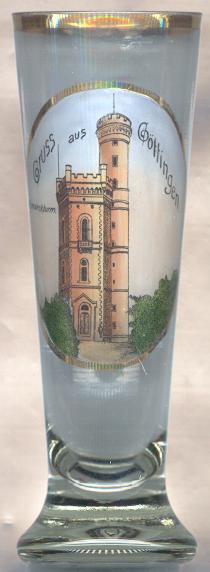

|
| DEUTSCHLAND | GERMANY |
| Bundesland: Niedersachsen | Lower Saxony |
| Landkreis: Göttingen |
Göttingen on the river Leine was first mentioned as Gutingi in a document in AD 953 when Emperor Otto I gave the village to the
monastery St. Moritz in Magdeburg. At that time the emperors had a residence at the other side of the river (Pfalz Grona). While Grona
was destroyed by Duke Heinrich ('the Lion') of Saxony around 1180, a market developed at the ford across the Leine and the crossroads
of two important trading routes. This market later also was called Gutingi and obatined the status of a town ind 1210. The flourishing period as a trading place was
the time between 1351 and 1572 when the town was part of the Hanse, the union of the largest trading cities in northern Europe. At the end of the 16th century the
wealth of the town decreased and after the Thirty Year's War it was only a small country town any more. A new period of growth was initiated in 1734 when
Georg II August, Elector of Hannover and King of Great Britain, founded the university of Göttingen which soon gained international recognition. In 1837 Ernst
August, King of Hannover, cancelled the liberal constitution of his country. Seven professors of the university ('die Göttinger Sieben'), among them the brothers
Jakob and Wilhelm Grimm, protested and were dismissed by the king. Only the dismissal of numerous jewish and liberal proffessors by the Nazi regime was a
greater loss for the intellectual life of the university. Today, the university is one of the most important institutions of its kind in Germany again.

Not less than 45 Nobel Prize winners have studied, worked or lived at Göttingen, among them
Robert KOCH (1843–1910, Nobel Prize for Physiology and Medicine 1905),
Rudolf Christoph EUCKEN (1846–1926, Nobel Prize for Literature 1908),
Otto WALLACH (1847–1931, Nobel Prize for Chemistry 1910),
Paul EHRLICH (1854–1915, Nobel Prize for Physiology and Medicine 1908),
Max PLANCK (1858–1947, Nobel Prize for Physics 1918),
Johannes STARK (1874–1957, Nobel Prize for Physics 1919),
Max von LAUE (1879–1960, Nobel Prize for Physics 1914),
Otto HAHN (1879–1968, Nobel Prize for Chemistry 1944 and 1966),
Irving LANGMUIR (1881–1957, Nobel Prize for Chemistry 1932),
James FRANCK (1882–1964, Nobel Prize for Physics 1925),
Max BORN (1882–1970, Nobel Prize for Physics 1954),
Wolfgang PAULI (1900–1958, Nobel Prize for Physics 1945),
Werner HEISENBERG (1901–1976, Nobel Prize for Physics 1932),
Maria GOEPPERT-MAYER (1906–1972, Nobel Prize for Physics 1963),
Manfred EIGEN (b.1927, Nobel Prize for Chemistry 1967)
and Erwin NEHER (b.1954, Nobel Prize for Physiology and Medicine 1991).

The  Stadttheater (Municipal Theatre) [left, no. 1542: bottom left]
was built in neo-Renaissance style in 1889–1890 by the Oldenburg court architect Gerhard Schnitger.
In 1943 the theatre was renamed 'Theater der Stadt Göttingen' (Theatre of the City of Göttingen).
Productions of operas and operettas were discontinued in 1950.
Since then its current name is 'Deutsches Theater' (German Theatre).
Stadttheater (Municipal Theatre) [left, no. 1542: bottom left]
was built in neo-Renaissance style in 1889–1890 by the Oldenburg court architect Gerhard Schnitger.
In 1943 the theatre was renamed 'Theater der Stadt Göttingen' (Theatre of the City of Göttingen).
Productions of operas and operettas were discontinued in 1950.
Since then its current name is 'Deutsches Theater' (German Theatre).
The  Bismarckturm (height 31.5 m) [right, no. 711]
on the Hainberg (Kleperberg) was erected in 1892–1896. It was named after Reichskanzler Otto von Bismarck (1815–1898), the founder
of the German Empire 1870/71. The tower is open to the public and offers a splendid view on Göttingen.
Bismarckturm (height 31.5 m) [right, no. 711]
on the Hainberg (Kleperberg) was erected in 1892–1896. It was named after Reichskanzler Otto von Bismarck (1815–1898), the founder
of the German Empire 1870/71. The tower is open to the public and offers a splendid view on Göttingen.
Several glasses of this collection show other Bismarck monuments.
![[scale]](lineal.jpg)